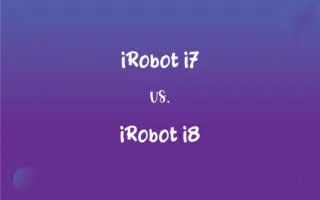DOS vs. Windows: What's the Difference?
Edited by Janet White || By Harlon Moss || Published on February 7, 2024
DOS is a text-based, single-tasking operating system, whereas Windows is a graphical, multitasking OS developed later by Microsoft.

Key Differences
DOS (Disk Operating System) is primarily a command-line interface, relying on text commands, while Windows provides a graphical user interface (GUI) with visual elements like icons and windows.
DOS operates on a single-tasking basis, meaning it can run only one program at a time, whereas Windows supports multitasking, allowing multiple programs to run simultaneously.
Windows offers more user-friendly features, including drag-and-drop functionality and comprehensive support for multimedia, unlike DOS, which is more basic and text-focused.
DOS was predominant in the early era of personal computing, while Windows, introduced later, has become the standard OS for most personal and business computers.
In terms of hardware compatibility and driver support, Windows supports a wide range of modern hardware, whereas DOS is limited to older, less sophisticated hardware.
ADVERTISEMENT
Comparison Chart
Interface
Command-line (text-based)
Graphical User Interface (GUI)
Tasking Capability
Single-tasking
Multitasking
User-Friendly Features
Limited, primarily text commands
Extensive, including drag-and-drop
Era of Dominance
Early personal computing (1980s)
Late 20th century to present
Hardware Compatibility
Limited to older hardware
Wide range of modern hardware
ADVERTISEMENT
DOS and Windows Definitions
DOS
DOS is a command-line operating system used in early personal computers.
To copy a file in DOS, you would type the command COPY file1.txt file2.txt.
Windows
Windows provides extensive hardware and software compatibility.
Windows 10 is compatible with a wide range of hardware and software.
DOS
DOS does not support modern graphical applications.
Classic text-based games like Zork were popular on DOS systems.
Windows
Windows is a graphical operating system offering a user-friendly interface.
In Windows, you can click on icons to open programs.
DOS
DOS is limited to single-tasking operations.
While using a program in DOS, you cannot simultaneously open another program.
Windows
Windows supports multitasking, allowing multiple programs to run at once.
In Windows, you can have a web browser, word processor, and music player open simultaneously.
DOS
DOS requires users to type commands for operations.
To view files in a directory in DOS, you would use the DIR command.
Windows
Windows includes features like the Start menu and taskbar for easy navigation.
You can access programs and settings from the Start menu in Windows.
DOS
DOS is known for its simplicity and low hardware requirements.
DOS was commonly used in the 1980s on IBM PCs.
Windows
Windows has evolved through several versions, each with more features.
Windows XP was a major upgrade from its predecessors, introducing a new interface.
DOS
Any of a family of operating systems that use command lines and were originally developed for personal computers made by IBM.
Windows
Plural of window
DOS
Plural of do
DOS
(music) do
DOS
The federal department in the UnitedStates that sets and maintains foreign policies;
The Department of State was created in 1789
DOS
An operating system that is on a disk
FAQs
Does Windows support command-line operations?
Yes, through utilities like Command Prompt and PowerShell.
Is DOS still in use today?
It's largely outdated but may be used in specific legacy systems.
What is Windows?
A graphical, multitasking operating system.
Can DOS run graphical applications?
No, it primarily supports text-based applications.
What is DOS?
A text-based, single-tasking operating system.
Does Windows support modern gaming?
Yes, it supports a wide range of modern gaming applications.
Can Windows run DOS programs?
Yes, many DOS programs can be run in Windows using compatibility modes.
How does Windows handle multitasking?
It allows multiple applications to run and be managed simultaneously.
How user-friendly is the Windows interface?
It's designed to be intuitive and accessible to a wide range of users.
What are the hardware requirements for DOS?
Very minimal compared to modern operating systems.
Can DOS access the internet?
It has limited internet capabilities compared to Windows.
Was DOS used in early personal computers?
Yes, it was the primary OS for early IBM PCs and compatibles.
Is programming possible in DOS?
Yes, but with more limitations than in modern Windows environments.
Can DOS operate on modern computers?
It can, but it's generally incompatible with modern hardware features.
Are updates still released for DOS?
No, it's no longer actively updated.
Is DOS user-friendly for beginners?
It has a steep learning curve due to its command-line interface.
What are common uses for Windows today?
It's used in a wide array of applications, from personal computing to enterprise environments.
Does Windows have built-in security features?
Yes, it includes features like Windows Defender and firewall.
How has Windows evolved over time?
It has evolved significantly, with advancements in GUI, security, and functionality.
Is it easy to transition from DOS to Windows?
There's a learning curve, but Windows' GUI makes it more accessible for most users.
About Author
Written by
Harlon MossHarlon is a seasoned quality moderator and accomplished content writer for Difference Wiki. An alumnus of the prestigious University of California, he earned his degree in Computer Science. Leveraging his academic background, Harlon brings a meticulous and informed perspective to his work, ensuring content accuracy and excellence.
Edited by
Janet WhiteJanet White has been an esteemed writer and blogger for Difference Wiki. Holding a Master's degree in Science and Medical Journalism from the prestigious Boston University, she has consistently demonstrated her expertise and passion for her field. When she's not immersed in her work, Janet relishes her time exercising, delving into a good book, and cherishing moments with friends and family.







































































